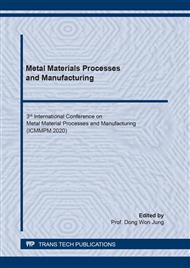p.43
p.51
p.59
p.65
p.71
p.79
p.85
p.91
p.97
Multi-Objective Optimization of PMEDM Input Factors for Processing Cylindrical Shaped Parts
Abstract:
The present work deals with multi-objective optimization of powder mixed electric discharge machining (PMEDM) when processing cylindrically shaped parts. In this work, the pulse on time Ton, the pulse off time Toff, the powder concentration Cp, the pulse current IP, and the server voltage SV were chosen for the optimization problem. Also, the surface roughness (SR), the material removal rate (MRR), and the electrode wear (EW) were chosen as three objectives for the investigation. Besides, the Taguchi method and the grey relational analysis (GRA) were applied for optimizing simultaneously three the SR, the MRR and the EW to find the optimum input factors. The impact of the process parameters on the overall goal was weighed. Additionally, optimum input factors of PMEDM process for multi-objectives were recommended.
Info:
Periodical:
Pages:
71-77
Citation:
Online since:
January 2021
Price:
Сopyright:
© 2021 Trans Tech Publications Ltd. All Rights Reserved
Share:
Citation:


